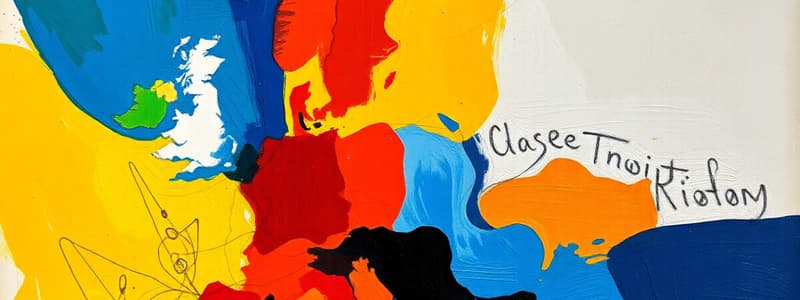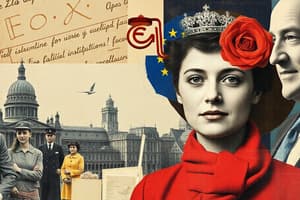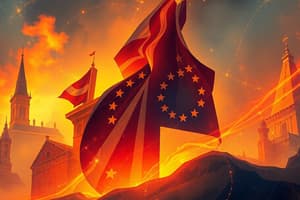Podcast
Questions and Answers
Which country approved the Treaty of Maastricht in its second referendum?
Which country approved the Treaty of Maastricht in its second referendum?
- Luxembourg
- Denmark (correct)
- Ireland
- France
What was the outcome of the Treaty Establishing a Constitution for Europe after the referendums in 2005?
What was the outcome of the Treaty Establishing a Constitution for Europe after the referendums in 2005?
- It was abandoned due to rejections by France and the Netherlands. (correct)
- It was approved by all member states.
- It faced no challenges in any member states.
- It was passed in France but rejected in the Netherlands.
Which phase of EU integration is described as 'eurosclerosis'?
Which phase of EU integration is described as 'eurosclerosis'?
- 1950s-mid 1960s
- 1986-1993
- 2005-2009
- Mid 1960s-1985 (correct)
In what year did Croatia join the European Union?
In what year did Croatia join the European Union?
What significant event happened in 2016 regarding the United Kingdom's relationship with the EU?
What significant event happened in 2016 regarding the United Kingdom's relationship with the EU?
Which event represents a significant halt to the Arab expansion into Europe?
Which event represents a significant halt to the Arab expansion into Europe?
Which concept serves as a unifying theme described in Charlemagne's Carolingian Empire?
Which concept serves as a unifying theme described in Charlemagne's Carolingian Empire?
What political resolution method was proposed by Abbé de Saint-Pierre in 1713?
What political resolution method was proposed by Abbé de Saint-Pierre in 1713?
What major event occurred in 1919 that focused on reparations and military restrictions on Germany?
What major event occurred in 1919 that focused on reparations and military restrictions on Germany?
Which philosopher wrote about a Pacific federation of European states in 1795?
Which philosopher wrote about a Pacific federation of European states in 1795?
Who founded La Giovine Europa in 1834, advocating for freedom and brotherhood?
Who founded La Giovine Europa in 1834, advocating for freedom and brotherhood?
What was the primary focus of the Zollverein established in 1834?
What was the primary focus of the Zollverein established in 1834?
Which publication by Paul Valéry in 1919 discussed the relationship between the war and modernity?
Which publication by Paul Valéry in 1919 discussed the relationship between the war and modernity?
Which thinker is associated with the concept of a 'grand design' for a European federation in the 17th century?
Which thinker is associated with the concept of a 'grand design' for a European federation in the 17th century?
Which event is noted for its impact on the ideal of peaceful Franco-German relations?
Which event is noted for its impact on the ideal of peaceful Franco-German relations?
What primary concern contributed to the failure of the initial plan for European integration?
What primary concern contributed to the failure of the initial plan for European integration?
What concept did Arnold Toynbee introduce to describe Europe's declining global influence?
What concept did Arnold Toynbee introduce to describe Europe's declining global influence?
Which document, written in 1941, called for a federal Europe with a supranational government?
Which document, written in 1941, called for a federal Europe with a supranational government?
Which event led to the establishment of the European Coal and Steel Community?
Which event led to the establishment of the European Coal and Steel Community?
What was the primary purpose of the Marshall Plan initiated in 1948?
What was the primary purpose of the Marshall Plan initiated in 1948?
What significant proposal did Pleven make regarding European defense?
What significant proposal did Pleven make regarding European defense?
What was a primary outcome of the Treaties of Rome signed in March 1957?
What was a primary outcome of the Treaties of Rome signed in March 1957?
Which event is considered directly responsible for the establishment of the European Movement?
Which event is considered directly responsible for the establishment of the European Movement?
What was the impact of the Nazi party's rise to power in Germany on European civilization?
What was the impact of the Nazi party's rise to power in Germany on European civilization?
Which year marked the unsuccessful uprisings in East Germany and Hungary that challenged stability in Eastern Europe?
Which year marked the unsuccessful uprisings in East Germany and Hungary that challenged stability in Eastern Europe?
What was the main purpose of the Western European Union established in 1955?
What was the main purpose of the Western European Union established in 1955?
Which speech outlined Britain's vision for a united Europe while maintaining independence?
Which speech outlined Britain's vision for a united Europe while maintaining independence?
What did the Spaak Report of 1956 outline?
What did the Spaak Report of 1956 outline?
What major consequence followed the division of Germany in 1949?
What major consequence followed the division of Germany in 1949?
Which proposal was rejected by the Benelux countries during 1961-1962?
Which proposal was rejected by the Benelux countries during 1961-1962?
In what year did Britain formally apply for membership in the European Economic Community?
In what year did Britain formally apply for membership in the European Economic Community?
What was the primary aim of the European Security and Defence Policy (ESDP) established in 1999?
What was the primary aim of the European Security and Defence Policy (ESDP) established in 1999?
What was the focus of the European Neighbourhood Policy adopted in 2004?
What was the focus of the European Neighbourhood Policy adopted in 2004?
Flashcards
Homeric "Hymn to Apollo"
Homeric "Hymn to Apollo"
The first documented mention of "Europe" as a distinct geographic area.
Herodotus' Histories
Herodotus' Histories
Herodotus questioned the strict separation of Europe and Asia, challenging the early understanding of European identity.
Roman Empire's 'myth' of superiority
Roman Empire's 'myth' of superiority
The Roman Empire's perception of itself as superior to Asia and Africa laid the foundation for a sense of European dominance.
Battle of Tours (732 CE)
Battle of Tours (732 CE)
Signup and view all the flashcards
Charlemagne and 'Christendom'
Charlemagne and 'Christendom'
Signup and view all the flashcards
Fall of Constantinople (1453)
Fall of Constantinople (1453)
Signup and view all the flashcards
Discovery of the New World (1492)
Discovery of the New World (1492)
Signup and view all the flashcards
Thirty Years' War and Peace of Westphalia
Thirty Years' War and Peace of Westphalia
Signup and view all the flashcards
Enlightenment Values
Enlightenment Values
Signup and view all the flashcards
Leibniz's Idea of a Unified Europe
Leibniz's Idea of a Unified Europe
Signup and view all the flashcards
Failed European Integration Plan (1920s)
Failed European Integration Plan (1920s)
Signup and view all the flashcards
Joseph Roth's View on European Unity (1930s)
Joseph Roth's View on European Unity (1930s)
Signup and view all the flashcards
The Nazi Party's Vision of Europe (1930s)
The Nazi Party's Vision of Europe (1930s)
Signup and view all the flashcards
The Dwarfing of Europe (1934-1961)
The Dwarfing of Europe (1934-1961)
Signup and view all the flashcards
The Ventotene Manifesto (1941)
The Ventotene Manifesto (1941)
Signup and view all the flashcards
European Federalist Movement (1943)
European Federalist Movement (1943)
Signup and view all the flashcards
European Federalists Conference in Geneva (1944)
European Federalists Conference in Geneva (1944)
Signup and view all the flashcards
Churchill's "Three Circles" Speech (1946)
Churchill's "Three Circles" Speech (1946)
Signup and view all the flashcards
European Convention on Human Rights - Origins
European Convention on Human Rights - Origins
Signup and view all the flashcards
Schuman Declaration and the ECSC
Schuman Declaration and the ECSC
Signup and view all the flashcards
Treaty of Paris and the ECSC
Treaty of Paris and the ECSC
Signup and view all the flashcards
Messina Conference
Messina Conference
Signup and view all the flashcards
Spaak Report
Spaak Report
Signup and view all the flashcards
Treaties of Rome and EEC/Euratom
Treaties of Rome and EEC/Euratom
Signup and view all the flashcards
EFTA - Alternative to the EEC
EFTA - Alternative to the EEC
Signup and view all the flashcards
Fouchet Plans and Rejection
Fouchet Plans and Rejection
Signup and view all the flashcards
Croatia's EU Accession
Croatia's EU Accession
Signup and view all the flashcards
What is 'eurosclerosis'?
What is 'eurosclerosis'?
Signup and view all the flashcards
The EU-Turkey Agreement (2016)
The EU-Turkey Agreement (2016)
Signup and view all the flashcards
What did the Treaty of Maastricht establish?
What did the Treaty of Maastricht establish?
Signup and view all the flashcards
What was the Treaty of Lisbon's goal?
What was the Treaty of Lisbon's goal?
Signup and view all the flashcards
Common Agricultural Policy (CAP)
Common Agricultural Policy (CAP)
Signup and view all the flashcards
Kennedy Round of GATT Negotiations
Kennedy Round of GATT Negotiations
Signup and view all the flashcards
Empty Chair Crisis
Empty Chair Crisis
Signup and view all the flashcards
Merger Treaty
Merger Treaty
Signup and view all the flashcards
Luxembourg Compromise
Luxembourg Compromise
Signup and view all the flashcards
Hague Summit
Hague Summit
Signup and view all the flashcards
Werner Report and EMU
Werner Report and EMU
Signup and view all the flashcards
Lomé Conventions
Lomé Conventions
Signup and view all the flashcards
Tindemans Report
Tindemans Report
Signup and view all the flashcards
European Monetary System (EMS)
European Monetary System (EMS)
Signup and view all the flashcards
Maastricht Treaty
Maastricht Treaty
Signup and view all the flashcards
Maastricht Criteria
Maastricht Criteria
Signup and view all the flashcards
Copenhagen Criteria
Copenhagen Criteria
Signup and view all the flashcards
Treaty of Amsterdam
Treaty of Amsterdam
Signup and view all the flashcards
Treaty of Lisbon
Treaty of Lisbon
Signup and view all the flashcards
Study Notes
Timeline of European Integration
- 7th/6th century BCE: Homeric "Hymn to Apollo" contains the first recorded reference to "Europe" as a distinct geographic area.
- 484-425 BCE: Herodotus' Histories questioned the clear demarcation of Europe from Asia and the origins of the name "Europe".
- Roman Empire: The idea of a superior Roman Europe was a foundational myth, contrasting it with Asia and Africa.
- 732 CE: Arab expansion halted at the Battle of Tours in France. An account refers to the forces led by Charles Martel as "Europeans", highlighting the concept of "Europeans."
- Charlemagne: The Carolingian Empire was referred to as Roman, Christian, and "Europe" ("Christendom" as a unifying concept).
- 1453: Fall of Constantinople and Ottoman advance into Europe reinforced the perceived external Islamic threat.
- 1492: Discovery of the New World emphasized European superiority.
- 1533: "Europa Regina", an illustration by Johannes Putsch, further emphasized "Europe".
- 1618-1648: Thirty Years War and the Peace of Westphalia marked a shift from religious wars to political and cultural issues, focusing on peace between major states.
- 1632: Duke of Sully's "grand design" proposed a European federation of states to overcome religious wars via international organization.
- Enlightenment: Ideas of rationality, justice, democracy, individual freedom, secularism, and tolerance emerged. Leibniz envisioned a political union of Europe.
- 1713: Abbé de Saint-Pierre proposed a "Projet de paix perpétuelle" – a secular European society/dispute resolution by arbitration/organized community of laws.
- 1756: Rousseau advocated a European federation for lasting peace with a shared morality and code.
Enlightenment and European Integration
-
1646-1716: Gottfried Wilhelm von Leibniz articulated a distinct vision of a united Europe, emphasizing a vision of humankind modeled on European concepts.
-
1795: Kant advocated for a "Perpetual Peace" through a Pacific federation of European states, promoting legal and cooperation in defense.
19th and 20th Century European Integration
-
1834: Formation of Zollverein (German customs union), although it didn't prevent political conflicts.
-
1834: Giuseppe Mazzini established 'La Giovine Europa' (Young Europe) to create a united Europe for freedom, unity, and brotherhood.
-
1850-1870: Ideas of race theory and national identity emerged, challenging previous concepts of a singular European identity.
-
1915, 1918, 1919: Various plans and initiatives, including "Mitteleuropa" by Friedrich Naumann, Oswald Spengler's "The Decline of the West", and the treaties of Versailles, highlighting the mood of crisis.
-
1919: J. M. Keynes critiqued the Treaty of Versailles.
-
1919: Paul Valéry emphasized challenges of modernity over traditional European values.
-
1923: Richard Coudenhove-Kalergi founded Pan-European Movement.
-
1929: Wall Street Crash marked the start of the Great Depression.
-
1930s: Rise of Nazi Germany and Joseph Roth's concerns about nationalism undermining Europe.
-
1934-61: Arnold Toynbee described a Europe losing dominance to Westernization.
-
1941: Ventotene Manifesto advocated a federal, supranational European state.
-
1943: Formation of the European Federalist Movement.
-
1944: European Federalists convened in Geneva for a European-controlled army and constitution.
-
1946-1948: Post-WWII Europe divided. Churchill's "Three Circles" speech outlined a vision for Britain's role in the postwar world.
-
1947: Truman Doctrine and Marshall Plan committed the U.S. to rebuilding Europe.
-
1948: OEEC (Organization for European Economic Cooperation) was established to administer the Marshall Plan.
-
1948-1950: The American Committee on a United Europe provided assistance to the European Movement.
-
1950: Schuman Declaration proposed the European Coal and Steel Community (ECSC).
-
1950-1953: The Korean War intensified Cold War tensions, promoting discussion of a unified European defense force.
-
1951: Treaty of Paris/ECSC established.
-
1952: Netherlands proposed a common market.
-
1953-1956: Unsuccessful uprisings in Eastern Europe highlighted the challenges to stability.
-
1955: The Western European Union (WEU) established, aiming for West German rearmament within NATO.
-
1955: Jean Monnet argued for sectoral integration of nuclear energy.
-
1956: Suez Crisis weakened Britain and France.
-
1956: Spaak Report outlined plans for a common market and nuclear energy community.
-
1957: Treaties of Rome established the European Economic Community (EEC) and the European Atomic Energy Community (Euratom).
-
1957-1961: EEC economic success.
-
1960: European Free Trade Association (EFTA) formed.
-
1961: Britain applied for EEC membership, and Greece became an associate member.
-
1962: Common Agriculture Policy (CAP) established.
-
1963: De Gaulle vetoed Britain's EEC application.
-
1964-1967: Kennedy Round of GATT negotiations.
-
1965-1966: Empty Chair Crisis over agricultural policy.
-
1965: Merger Treaty combined EEC, ECSC, and Euratom execs.
-
1966: Luxembourg Compromise prioritized national interests and shifted the EU towards intergovernmentalism.
-
1967-1969: Further applications for membership.
-
1969: Hague Summit relaunched negotiations for British membership.
-
Early 1970s: Bretton Woods system collapse.
-
1970: Werner Report proposed Economic and Monetary Union (EMU).
-
1970: Dáivignon Report proposed political cooperation.
-
1973, 1979, and 1981: Member state expansion, with Britain (1973) initially rejecting EEC membership.
-
1974: President Giscard d'Estaing established the European Council.
-
1975: Lomé Convention and Tindemans report.
-
1984: Fontainebleau Summit, focused on CAP spending controls.
-
1985: Milan European Council advocated the drafting of the Single European Act.
-
1986: Single European Act (SEA) focused on a single market.
-
1987-1992: Delors Commission Reports outlined a roadmap for a single market, economic cohesion.
-
1988: Margaret Thatcher's Bruges Speech cautioned against a federal Europe.
-
1989: Berlin Wall fell.
-
1990: German reunification completed.
-
1990-1992: Further debates and expansions of the EU.
-
1993: Maastricht Treaty established the European Union and the pathway to the Euro.
-
1995: Austria, Finland, and Sweden joined the EU.
-
1997: Treaty of Amsterdam.
-
1999: Euro launched as an accounting currency.
-
2001: Treaty of Nice.
-
2004: Enlargement with 10 new member states, emphasizing Eastern and Central European accession.
-
2004: Treaty establishing a Constitution for Europe (rejected by France and the Netherlands).
-
2007: Treaty of Lisbon (revised version of the failed Constitutional Treaty.)
-
2008-2009: Global Financial Crisis impacted the Eurozone.
-
2012-2013: Fiscal Compact/Treaty on Stability, Coordination and Governance.
-
2013: Croatia joined the EU.
-
2016: Brexit referendum.
-
2020: Brexit concluded.
Phases of EU Integration
-
1950s-mid 1960s: Rebuilding Europe.
-
Mid 1960s-1980s: Euro-sclerosis.
-
1986-1993: Deeper and broader integration.
-
1993-2005: EU-phoria.
-
2005-2009: Constitutional crisis.
-
2010 - present: Polycrisis.
List of Treaties and Referendums
- (Succeeding treaties) and (Failed/Challenges.)*
- Treaty of Maastricht (1992):
- Ireland (1992): Succeeded
- Denmark (1992): Failed/challenges
- Treaty of Amsterdam (1997):
- Ireland (1998): Succeeded
- Treaty of Nice (2001):
- Ireland (2001/2002): Succeeded
- Treaty Establishing a Constitution for Europe (2004):
- France (2005), Netherlands (2005): Failed
- Spain (2005), Luxembourg (2005): Succeeded
- Treaty of Lisbon (2007): Succeeded.
- Ireland (2008/2009): Failed/Challenges
Studying That Suits You
Use AI to generate personalized quizzes and flashcards to suit your learning preferences.




